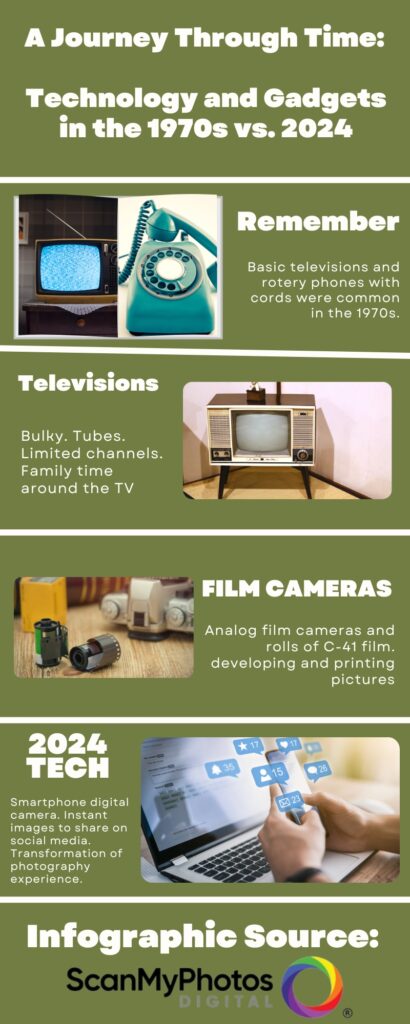A Journey Through Time: Exploring the Past and Present of Tech Gadgets
 Welcome to our digital time machine! Today, we take a fun trip down memory lane, exploring how technology and gadgets have changed from the 1970s to 2024. It’s impressive to see how far we’ve come.
Welcome to our digital time machine! Today, we take a fun trip down memory lane, exploring how technology and gadgets have changed from the 1970s to 2024. It’s impressive to see how far we’ve come.
Tech in the 1970s
Telephones: Then and Now
In the 1970s, telephones were big and clunky. People used rotary dial phones attached to the wall. If you wanted to call someone, you had to turn a dial and remember their number. Long-distance calls cost a lot of money; you must search through a phone book if you forget the number.
Today, smartphones have transformed communication. They fit in your pocket and do much more than just make calls. You can text, browse the internet, and download apps that help with almost anything! Isn’t it cool how far we’ve come?
TVs: A Big Change
TVs in the 1970s were huge, heavy boxes with limited channels. Families gathered around their cathode ray tube (CRT) TVs to watch their favorite shows and news. If you missed a show, you had to wait for a rerun!
Now, we have sleek, flat-screen TVs. These high-definition TVs connect us to endless entertainment options through cable, satellite, and streaming services. You can watch your favorite shows whenever you want. How awesome is that?
Computers: From Huge to Handheld
Computers in the 1970s were massive machines. Only big companies or universities had them, and they were slow. People used punch cards to program them. Can you imagine waiting for a computer to run a simple task?
Fast forward to today, and computers are everywhere! Laptops, tablets, and even smartphones are powerful and efficient. They help us with schoolwork, games, and keeping in touch with friends. Technology makes our lives easier and more fun!
Cameras: Capturing Moments
People used film cameras to take pictures in the 1970s. You had to be careful when framing your shot because you couldn’t see what you took until the film was developed. This process took time; you never knew if your pictures turned out well.
Now, we have digital cameras and smartphones that let us snap pictures instantly. With just a click, we can share our photos on social media platforms like Instagram, Facebook, and TikTok. Capturing memories has never been this easy!
Tech in 2024
Smartphones: A World of Possibilities
Today’s smartphones are like mini-computers. They allow us to make calls, send texts, and access the internet anytime. With so many apps, you can learn, play, and even shop from your phone. They have changed how we communicate and live our daily lives.
TVs: Endless Entertainment
Modern TVs offer incredible entertainment options. You can watch movies, shows, and documentaries on demand. Streaming services give you access to a world of content, so you never run out of things to watch. What will you choose next?
Computers: Compact and Powerful
Today’s computers are smaller and more powerful than ever. They help us work, learn, and connect with others. From school projects to gaming, we rely on these amazing devices. They fit into our lives seamlessly, making tasks easier and faster.
Cameras: Instant Gratification
Photography has changed dramatically. Digital cameras and smartphones let us capture and share our lives in seconds. Now, you can see your pictures right away! This instant feedback makes photography a fun way to document your experiences.
How Things Changed
Communication: From Cords to Connection
We moved from using simple corded phones to having smartphones that keep us connected. We can reach out to friends and family anytime and anywhere. Communication has never been easier!
Accessing Information: Libraries to the Internet
In the 1970s, you had to go to the library if you wanted information. Today, we can find answers online in seconds. The internet is a treasure trove of knowledge right at our fingertips!
Entertainment: From Schedules to Streaming
Television used to be about scheduled broadcasts. Now, with streaming services, we can watch what we want when we want. This change offers more choices and flexibility for our entertainment.
Computing Power: From Gigantic to Portable
Computers have transformed from massive machines to portable devices. We use them for everything, making our lives more productive and enjoyable. They are now essential to our daily routines.
Conclusion
Technology has changed so much from the 1970s to 2024. We’ve moved from bulky gadgets to sleek, powerful devices that fit into our lives. This progress gives us more opportunities to connect, create, and share. Let’s embrace the magic of technology and keep looking forward!
Call to Action
To preserve your memories in this digital age, consider digitizing your photos with ScanMyPhotos.com. Don’t wait! Digitize my pictures now!





